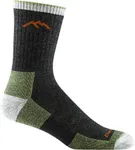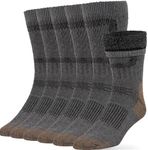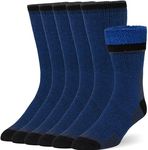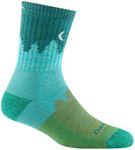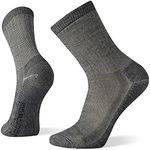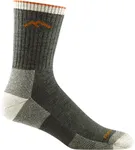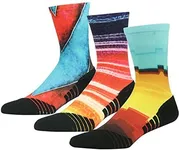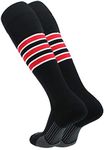Buying Guide for the Best Winter Hiking Socks
Choosing the right winter hiking socks is crucial for ensuring comfort, warmth, and protection during your outdoor adventures. The right pair of socks can make a significant difference in your hiking experience, preventing blisters, keeping your feet warm, and providing the necessary support. Here are some key specifications to consider when selecting winter hiking socks and how to choose the best fit for your needs.MaterialThe material of the socks is important because it affects warmth, moisture-wicking ability, and comfort. Common materials include wool, synthetic fibers, and blends. Wool, especially merino wool, is excellent for warmth and moisture management. Synthetic fibers like polyester and nylon are good for durability and quick drying. Blends often combine the best properties of different materials. Choose wool for maximum warmth and comfort, synthetics for durability and moisture control, or blends for a balance of both.
ThicknessThickness determines the level of insulation and cushioning. Winter hiking socks come in various thicknesses: lightweight, midweight, and heavyweight. Lightweight socks are good for mild conditions and when you need more breathability. Midweight socks offer a balance of warmth and cushioning, suitable for most winter hikes. Heavyweight socks provide maximum insulation and cushioning, ideal for extremely cold conditions. Choose the thickness based on the temperature and the intensity of your hike.
FitA proper fit is essential to prevent blisters and ensure comfort. Socks should fit snugly without being too tight. Pay attention to the heel cup and toe box; they should align well with your feet. Some socks offer specific left and right foot designs for a better fit. Try on socks with your hiking boots to ensure they fit well together. Choose a fit that feels comfortable and secure, without any bunching or slipping.
CushioningCushioning provides extra comfort and protection, especially on rough terrains. Socks can have different levels of cushioning: no cushioning, light cushioning, medium cushioning, and heavy cushioning. No cushioning is best for minimalists or short hikes. Light cushioning offers some comfort without bulk. Medium cushioning provides a good balance for longer hikes. Heavy cushioning is ideal for long, strenuous hikes or carrying heavy loads. Choose the level of cushioning based on the terrain and the duration of your hike.
Moisture-WickingMoisture-wicking ability helps keep your feet dry by drawing sweat away from the skin. This is important to prevent blisters and maintain warmth. Materials like merino wool and certain synthetics excel at moisture-wicking. Look for socks labeled as moisture-wicking or with specific technologies designed for this purpose. Choose socks with good moisture-wicking properties if you tend to sweat a lot or if you expect wet conditions.
HeightThe height of the socks affects coverage and protection. Common heights include ankle, crew, and knee-high. Ankle socks are best for low-cut hiking shoes and mild conditions. Crew socks provide more coverage and are suitable for most hiking boots. Knee-high socks offer maximum coverage and warmth, ideal for deep snow or very cold conditions. Choose the height based on your hiking footwear and the level of protection you need.
DurabilityDurability ensures that your socks will last through many hikes. Reinforced areas like the heel and toe can enhance durability. Materials like nylon and certain blends are known for their strength. Check for reviews or product descriptions that mention durability features. Choose durable socks if you hike frequently or on rough terrains.
